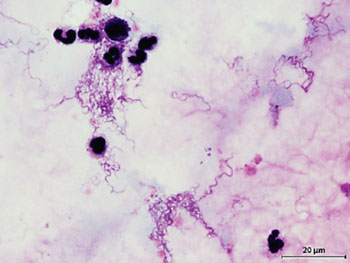Louse-Borne Relapsing Fever Surfaces in Europe
By LabMedica International staff writers
Posted on 17 Aug 2015
Borrelia recurrentis, a causative agent of relapsing fever, has for many centuries caused infections of often epidemic proportions and currently the disease is primarily found in north-eastern Africa, but is rarely seen in Europe. Posted on 17 Aug 2015
Since the infection is exclusively transmitted by body lice and humans are their only host, large scale outbreaks are only expected under circumstances conducive to louse infestation. Lice that feed on infected humans acquire the Borrelia organisms that then multiply in the gut of the louse. When an infected louse feeds on an uninfected human, the organism gains access when the victim crushes the louse or scratches the area where the louse is feeding. B. recurrentis infects the person via mucous membranes and then invades the bloodstream.

Image: Giemsa stained thick blood film showing spirochetes from a patient with louse-borne relapsing fever (Photo courtesy of B. Huizinga).
Medical microbiologist at the University Medical Center Groningen (The Netherlands) investigated young asylum seekers from Eritrea one who presented with a history of headache, dizziness, right upper quadrant pain, myalgia, and a temperature of 39.3 °C. Another patient resented with general malaise, headache, a temperature of 38.5 °C and cough and his blood tests showed elevated inflammatory parameters, leucocytes count was 12.7 × 109/L, C-reactive protein (CRP) level of 320 mg/L. Malaria was suspected.
Thick and thin blood films did not show malaria parasites and commercial malaria antigen tests were negative. Filamentous unidentified structures were reported in the thick film by the laboratory of the peripheral hospital and louse-borne relapsing fever was suspected. Borrelia recurrentis was confirmed by 16S rDNA polymerase chain reaction (PCR) and sequencing directly from blood. The body louse Pediculus humanus humanus was recovered from their clothing. The patients’ clinical deterioration was provoked by the ceftriaxone administration leading to a severe Jarisch–Herxheimer reaction, so treatment was switched to doxycycline intravenously to reduce the risk of relapse.
The authors concluded that because infections with B. recurrentis pose a significant health risk to other migrants, aid workers, and healthcare personnel and arguably to the general population, screening and delousing should be considered for arriving migrants already at ports of entry into the European Union. The patients may have acquired body lice before arriving in Europe, but transmission of infected lice between migrants after arrival in Europe cannot be ruled out and could pose an additional public health challenge. The study was published on July 30, 2015, in the journal Eurosurveillance.
Related Links:
University Medical Center Groningen














